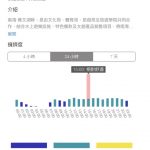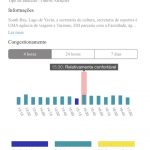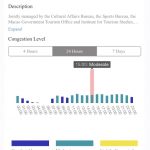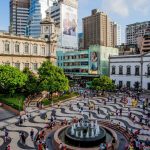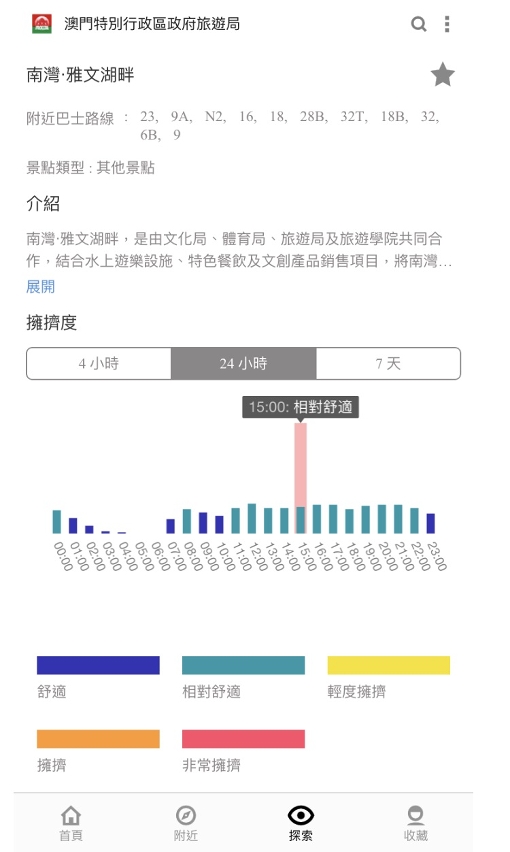 “Smart application for visitor flows” predicts the density of visitor flows at tourist attractions
“Smart application for visitor flows” predicts the density of visitor flows at tourist attractions
Macao Government Tourism Office (MGTO) officially launched three smart tourism projects into service today (26 March), fully capitalizing on the leading technology of Alibaba Cloud on cloud computing, big data application and other areas to push forward smart tourism. The projects are expected to bring greater convenience for visitors, industry operators and residents in Macao.
In parallel with the Macao Special Administrative Region Government’s strategies to develop Macao into a smart city along with action plans formulated in the Macao Tourism Industry Development Master Plan (“Master Plan”), MGTO has progressively unfolded an array of smart tourism projects. Among them, MGTO is undergoing the first stage of collaboration with Alibaba Cloud, a subsidiary of Alibaba Group, to foster smart tourism development, putting into service three projects known as “tourism information interchange platform”, “application for visitor insights” and “smart application for visitor flows”. As technology application continues to deepen in the area of smart tourism, the quality of travel experiences will be significantly enhanced, considerably lessening the impact of visitor crowds on residents and tourist districts.
Serving as a foundation for various smart tourism projects, the “tourism information interchange platform” was constructed upon the cloud computing platform of the Macao SAR Government to compile different types of tourism-related data resources in Macao. By formulation of unified data standards and rules, the platform will foster sharing and exchange of tourism data resources across the tourism industry, to provide data support for planning and development of Macao’s tourism industry.
The “application for visitor insights” obtains data from the “tourism information interchange platform” and gains insights into the basic and behavioral nature of visitors through analysis of big data, thus obtaining an overview of travel activities, preferences and behavior of visitors in Macao. In the future, MGTO will solicit feedback from the travel trade and learn about their demand on the “application for visitor insights” to optimize the functions and deliver the most far-reaching impact of the application.
Based on data acquired from the “tourism information interchange platform”, the “smart application for visitor flows” predicts the density of visitor flows at monitored tourist attractions within four hours, 24 hours and seven days by computation, and categorizes the forecast results at various levels from “comfortable”, “moderate”, “lightly congested”, “congested” to “heavily congested”, to create more convenient experiences for visitors and industry operators in their itinerary arrangement. At present, the “smart application for visitor flows” monitors 20 popular local tourist attractions including a number of attractions within the World Heritage Site – “The Historic Centre of Macao”, as well as other attractions around Taipa and Coloane.
At the same time, MGTO continues to partner with Public Security Police Force to enable the awareness of visitors, industry operators and residents about crowd control measures implemented by Public Security Police Force through the mobile version of the “smart application for visitor flows” via the following website: https://poimonitor.macaotourism.gov.mo
In a travel destination like Macao, smart tourism remains a significant component of Macao’s transformation into a smart city. In light of this, it has become MGTO’s major task to steer smart tourism towards new progress. In the Master Plan delivered in 2017, MGTO has mapped out a range of development strategies to enhance smart tourism under the guidance given by the Five-Year Development Plan (2016-2020) of the Macao Special Administrative Region.
MGTO will forge ahead to optimize various initiatives of smart tourism application to brand Macao as a smart tourism destination fueled by technology, to attain three major goals for smart tourism — “optimize visitors’ travel experiences before, during and after trips through different initiatives of smart tourism application”, “obtain insights into travelers’ behavior through big data application for in-depth analysis” and “monitor, divert and disperse visitor flows at tourist districts and congested areas through measures of information technology”.


